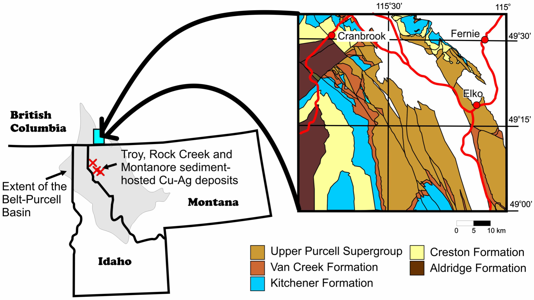Summary
The Middle Proterozoic Belt-Purcell Basin hosts the Purcell Supergroup in southeast British Columbia. The basin is believed to represent an intracontinental rift system that has been filled by both marine and fluviatile sediments. The Sullivan Mine, one of the world's largest SEDEX Pb-Zn deposits, is hosted in the Aldridge Formation of the lower Purcell Supergroup. Overlying rocks of the middle and upper Purcell Supergroup have received much less attention in B.C., even though they host several important sediment-hosted copper deposits in Montana (Spar Lake [Troy], Rock Creek, and Montanore).

- Detailed mapping of the geology, alteration patterns, and mineral occurrences of the economically important middle Creston Formation (Revett Formation in Montana).
- Examination of the petrology, geochemistry and economic potential of volcanic rocks of the Nicol Creek Formation.
- Geochemical and isotopic characterization of mafic dykes and felsic plutonic rocks in order to constrain their relationships with alteration zones and strata-bound mineralization.
Several sediment-hosted copper occurrences from the Cranbrook area were examined in detail as part of this project. U-Pb geochronology samples were collected in order to better constrain the age of these mineral occurrences. An important factor limiting exploration and development in the area is the limited bedrock exposure due to thick deposits of glacial drift. Fifty samples of lodgepole pine bark were collected to test biogeochemical exploration for concealed mineralization.